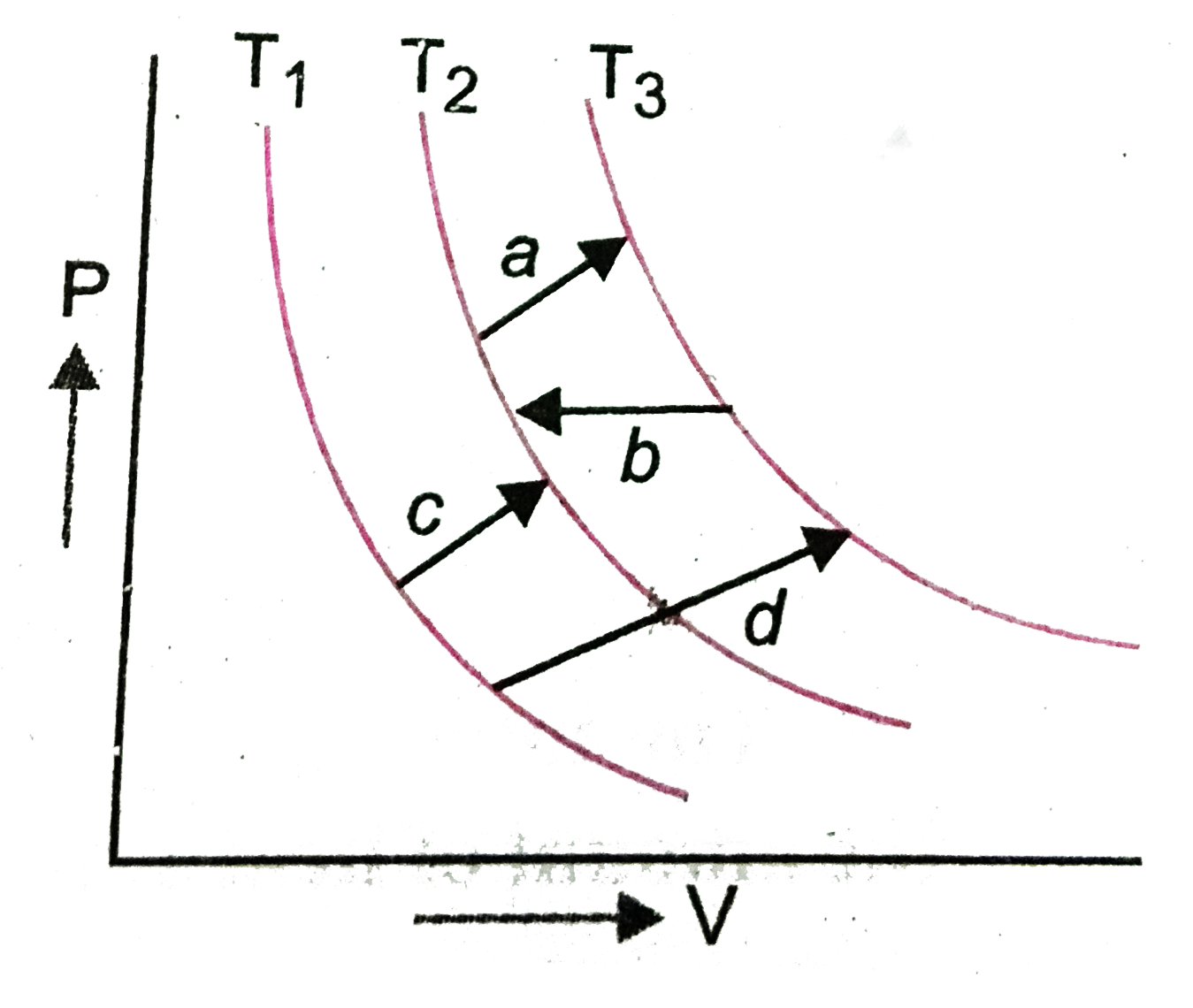A refrigerator is a device used for cooling things. Working substance would absorb a certain quantity of heat Q2 from the sink at lower temperature T2 and reject a larger amount of heat Q1 to the source (surrounding air) at higher temperature T1 (= room temperature) with the help of an external agency supplying energy W to the system.
Clearly, w=Q1−Q2
Cofficient of performance of refrigerator, βT2T1−T2=1−ηη
Read the above passage and answer the following questions:
(i) What is the cofficient of performance of a refrigerator working between −10∘C and 25∘C?
(ii) 'Refrigerator is an efficient room heater'. Do you agree with the statement? Justify.
(i) Here, T2=−10∘C=(−10+273)K=263K
T1=25∘C=(25+273)K=298K
C.O.P=β=T2T1−T2=263298−263=26335=7.5
(ii) Yes, the statement is true. This is because by consuming W units of energy, it delivers Q1 units of heat to the room from the condenser coils at the back of the refrigeraotr. And Q1=Q2+W, i.e., Q1>W. Thus, we pay for W units of energy and get Q1 unit of heat energy in the room, which is greater than W.
Topper's Solved these Questions
- BOOK - PRADEEPCHAPTER - THERMODYNAMICSEXERCISE - NCERT Questions10videos
THERMODYNAMICS
- BOOK - PRADEEPCHAPTER - THERMODYNAMICSEXERCISE - Multiple choice questions18videos
THERMODYNAMICS
- BOOK - PRADEEPCHAPTER - THERMODYNAMICSEXERCISE - Higher order thinking skills9videos
THERMODYNAMICS
- BOOK - PRADEEPCHAPTER - SYSTEMS OF PARTICLES AND ROTATIONAL MOTIONEXERCISE - Assertion- Reason Type questions20videos
SYSTEMS OF PARTICLES AND ROTATIONAL MOTION
- BOOK - PRADEEPCHAPTER - WORK, ENERGY AND POWEREXERCISE - Assertion-Reason Type Questions24videos
WORK, ENERGY AND POWER
Similar Questions
A geyser heats water flowing at the rate of 3.0 litre per minute from 27∘C to 77∘C. If the geyser operates on a gas burner and its heat of combustion is 4.0×104J/g, then what is the rate of combusion of fuel (approx.)?
03:59View SolutionThe physical quantity that determins whether or not a given system A is in thermal equilibrium with another system B is called
03:24View Solution(Figure) Shows three isothermal curves at temp T1,T2andT3
T3>T2>T1. A system changes its state by four paths a, b, c, and d, .Identify the path in which changes in internal energy of the system is maximum.
 07:54View Solution
07:54View SolutionAssertion : In rolling, all points of a rigid body have the same linear velocity.
Reason : The rotational motion does not affect the linear velocity.03:59View SolutionAssertion : When two equal masses undergo a glancing elastic collision with one of them at rest then after the collisioin, they will move at 90∘0 to eachtoerh.
Reason : It follows from the principle of conservation of linear momentum .04:20View SolutionA heat engine absorbs heat Q_(1) at temperature T_(1) and Q_(2) at temperature T_(2) . Work done by the engine is (Q_(1)+Q_(1)) . This data:
03:22View SolutionThe efficiency of a heat engine is defined as the ratio of the mechanical work done by the engine in one cycle to the heat absorbed from the high temperature source . eta = (W)/(Q_(1)) = (Q_(1) - Q_(2))/(Q_(1)) Cornot devised an ideal engine which is based on a reversible cycle of four operations in succession: isothermal expansion , adiabatic expansion. isothermal compression and adiabatic compression. For carnot cycle (Q_(1))/(T_(1)) = (Q_(2))/(T_(2)) . Thus eta = (Q_(1) - Q_(2))/(Q_(1)) = (T_(1) - T_(2))/(T_(1)) According to carnot theorem "No irreversible engine can have efficiency greater than carnot reversible engine working between same hot and cold reservoirs". A carnot engine whose low temperature reservoir is at 7^(@)C has an efficiency of 50% . It is desired to increase the efficiency to 70% . By how many degrees should the temperature of the high temperature reservoir be increased?
View SolutionThe efficiency of a heat engine is defined as the ratio of the mechanical work done by the engine in one cycle to the heat absorbed from the high temperature source . η=WQ1=Q1−Q2Q1 Cornot devised an ideal engine which is based on a reversible cycle of four operations in succession: isothermal expansion , adiabatic expansion. isothermal compression and adiabatic compression.
_E01_238_Q01.png)
For carnot cycle Q1T1=Q2T2. Thus η=Q1−Q2Q1=T1−T2T1 According to carnot theorem "No irreversible engine can have efficiency greater than carnot reversible engine working between same hot and cold reservoirs"._E01_238_Q02.png)
Efficiency of a carnot's cycle change from 16 to 13 when source temperature is raised by 100K. The temperature of the sink is-03:52View SolutionA heat engine absorbs heat Q_(1) at temperature T_(1) and heat Q_(2) at temperature T_(2) . Work done by the engine is (Q_(1)+Q_(2)) . This data
01:09View Solutionयदि कार्नो इंजन में स्त्रोत से T1 ताप पर ली गयी ऊष्मा Q1 तथा T2 ताप पर सिंक को दी गयी ऊष्मा Q2 हो तो निम्नलिखित में कौन - सा कथन सत्य हैं ?
02:16View Solutionआदर्श ऊष्मा इंजन में स्त्रोत व सिंक के ताप क्रमशः T1 तथा T2 स्त्रोत से ली गयी ऊष्मा Q1 तथा सिंक को दी गयी ऊष्मा Q2 है । इन राशियों में परस्पर क्या सम्बंध हैं ?
03:47View SolutionA heat engine absorbs heat Q1 at temperature T1 and heat Q2 at temperature T2, work done by the engine is J (Q1+Q2) this data
02:14View Solutionएक कार्नोट चक्र में कार्यशील पदार्थ T1 तापक्रम पर Q1 उष्मा अवशोषित करता है तथा T2 तापक्रम पर Q2 उष्मा मुक्त करता है । कार्नोट चक्र के दौरान होने वाला एंट्रोपी परिवर्तन है
03:09View SolutionA heat engine absorbs heat q1 from a source at temperature T1 and heat q2 from a source at temperature T2. Work done is found to be J(q1+q2). This is in accordance with
01:34View Solutionएक ऊष्मा इंजन एक स्रोत से ताप T1 पर q1 ऊष्मा अवशोषित करता है तथा एक अन्य स्रोत से तापा T2 पर q2 ऊष्मा अवशोषित करता है। किया गया कार्य (q1+q2)J पाया जाता है। यह किस नियम के अनुसार होता है?
03:24View Solution

